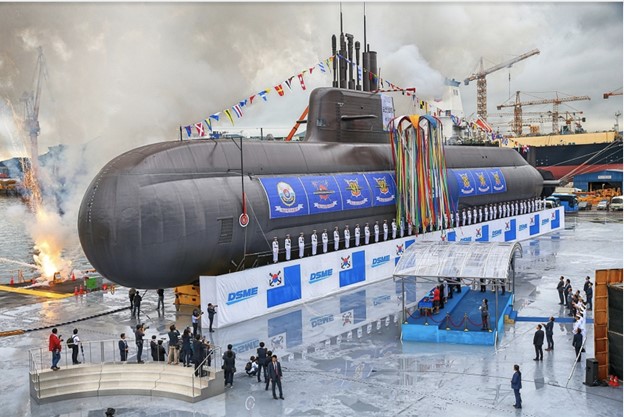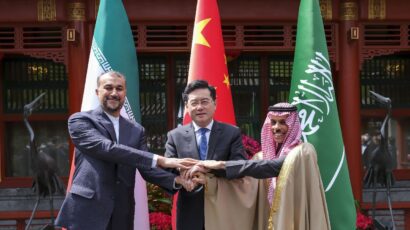South Korea’s risky quest to build nuclear-powered attack submarines
By Seoc Woo Kim, Jungmin Kang, Frank von Hippel | November 18, 2020

In mid-September, South Korea’s deputy national security advisor, Hyun-Chong Kim, visited Washington to discuss the possibility of the United States supplying fuel for proposed South Korean nuclear-powered attack submarines.
Why does South Korea want nuclear-powered submarines?
They do have advantages over their conventionally-powered counterparts. As Britain showed in 1982 when it sank Argentina’s cruiser, General Belgrano, during the Falklands war, a nuclear-powered submarine can, if necessary, travel at high speed invisibly below the ocean surface to anywhere in the world. And for countries that have nuclear weapons, the part of their arsenal that sits aboard nuclear-powered submarines is considered the most invulnerable, also because of the submarines’ ability to travel undetected for great distances in the deep oceans.
Modern conventional submarines are sufficient, however, for fending off foreign fleets from coastal waters, as a stealthy Swedish submarine demonstrated during a military exercise in 2005 by “sinking” a US nuclear-powered aircraft carrier and its protective destroyers and nuclear-powered attack submarines. Moreover, conventional submarines are substantially cheaper than their nuclear-powered counterparts. Sweden’s A26 submarines cost about five hundred million dollars each, while US Virginia-class nuclear-powered attack submarines will cost at least seven times as much at a production rate of about two per year, not including research and development and infrastructure costs.
In South Korea’s case, however, there is little military rationale for nuclear-powered submarines, and pursuing them may not be worth the political or financial costs. And in any case, international agreements may prevent South Korea from acquiring the fuel necessary to power them, either through direct purchase or through an indigenous enrichment capacity.
Which countries have nuclear-powered submarines? Only six countries—the United States, Russia, Britain, France, China, and India—have nuclear-powered submarines. These are all nuclear-armed countries with far flung interests.
The only non-nuclear-armed state that has seriously pursued a nuclear-powered attack submarine is Brazil, which has the largest gross domestic product of any country in the Southern Hemisphere. For four decades, Brazil’s navy has sought nuclear-powered submarines to patrol the South Atlantic. In the early 1980s, Brazil’s navy acquired gas-centrifuge uranium enrichment technology to fuel its future nuclear submarines. At that time, Brazil was governed by a brutal military junta, which compounded US suspicions that Brazil was pursuing nuclear weapons. The US cut Brazil off from high-tech exports such as supercomputers that might have been used for designing nuclear weapons. US concerns were only relieved after a civilian government took over from the junta in the 1990s, established a mutual nuclear inspection regime with Argentina in 1991, and joined the Nonproliferation Treaty in 1998. But the country’s interest in nuclear-powered submarines has not waned. Currently, with the assistance of a French defense contractor, it is building five submarines, the fifth of which is to be powered by a Brazilian-designed nuclear reactor.
Naval propulsion has also played a minor part in the more recent nuclear proliferation crisis relating to Iran’s uranium enrichment program. In 2013, during a confrontational period with the United States, before the Obama and Rouhani administrations reached their agreement on interim limits on Iran’s nuclear program, Iran stated that it was interested in naval nuclear propulsion as a rationale for producing highly enriched uranium, containing 20 percent or more uranium 235. By international agreement, highly enriched uranium is considered nuclear-weapon usable.
South Korea’s on-again, off-again interest in nuclear submarines. South Korea has had an on-again, off-again interest in acquiring nuclear attack submarines ever since 1994, the year of the first international crisis over North Korea’s plutonium separation program. Then-President Kim Young-sam ordered the Korea Atomic Energy Research Institute to design a nuclear-powered submarine reactor. The research institute is a politically-active organization that has, since its founding, tried to push the boundaries of what South Korea is allowed to do in the nuclear area, including especially plutonium separation. Kim Young-sam’s successor, President Kim Dae-jung— famous for his “sunshine” policy toward North Korea—cancelled the project. Instead, his administration ordered diesel-powered German submarines equipped with fuel cells powered by compressed hydrogen and oxygen for extended submerged operations.
Kim Dae-jung’s successor, President Roh Moo-hyun, relaunched the project to build nuclear-powered submarines in 2003 but, perhaps under US pressure, suspended it the following year. In 2010, Roh’s successor, Lee Myung-bak, discussed the possibility of purchasing nuclear-powered submarines with Britain’s Prime Minister Gordon Brown. Lee tried to assuage US proliferation concerns by specifying that the submarines would be fueled by non-weapon-usable low enriched uranium, enriched to less than 20 percent uranium 235. But UK nuclear submarines depend on US technology, and the US government probably vetoed the idea.
In 2015, North Korea gave new impetus to South Korea’s nuclear-powered submarine advocates by launching a ballistic missile from a diesel submarine. North Korea also has been carrying out nuclear tests with increasing yields, culminating in 2017 with a thermonuclear test with about ten times the explosive power of the Hiroshima and Nagasaki bombs. Since then, public opinion in South Korea has turned supportive of the country acquiring its own nuclear deterrent or inviting the US to redeploy nuclear weapons in South Korea. During the Cold War, the United States stationed up to 1,000 nuclear weapons in South Korea, but withdrew the last ones in 1991.
South Korea’s current President, Moon Jae-in, who came into office in 2017, tried to revive Kim Dae-jung’s sunshine policy and has evinced no interest in South Korea acquiring its own nuclear weapons. He has, however, expressed support for South Korea acquiring nuclear-powered attack submarines. Indeed, they were part of his electoral platform.
During his November 2017 meeting in Seoul with US President Donald Trump, President Moon raised the possibility of purchasing US nuclear-powered attack submarines. It is not clear what President Trump’s immediate response was, but the final answer appears to have been negative.
In March 2018, the South Korean Navy concluded that the country should follow the route taken by Brazil: South Korea would build a submarine similar to France’s Barracuda or Suffren-class nuclear attack submarine and equip it with a propulsion reactor designed by the Korea Atomic Energy Research Institute—possibly with Russian assistance. This past August, during the public presentation of the the country’s proposed five-year defense budget (2021–2025), a military official indicated the Defense Ministry’s strong interest in building three 4,000-ton displacement nuclear-powered attack submarines.
There are several possible reasons why President Moon has backed the South Korean Navy in seeking a nuclear-powered attack submarine. One reason might be that it is a way to deflect public pressure to acquire nuclear weapons, which would isolate the country internationally and most likely result in damaging economic sanctions. Following Brazil’s route might attract some suspicion, but if accompanied by scrupulous adherence to South Korea’s Nuclear Non-Proliferation Treaty obligations, it might be accepted, just as Japan’s uranium enrichment and reprocessing programs have been accepted.
The US–South Korea agreement on nuclear cooperation. If South Korea followed Brazil and Iran and built its own uranium enrichment capacity, that capacity could quickly be repurposed to make weapon-grade uranium for a bomb. This simple fact is what turned Brazil’s and Iran’s acquisitions of uranium enrichment technology into nonproliferation crises. The Moon administration would like to avoid such a crisis—especially with the United States, its principal security partner.
This is why South Korean Deputy National Security advisor Kim traveled to Washington in August 2020 with the request that the US supply South Korea with enriched uranium for its submarine reactors. That uranium could be 19.75 percent enriched, just below the 20 percent threshold for highly enriched uranium. France fuels its submarines with 6 percent low-enriched uranium. Brazil plans to fuel its nuclear submarine with low-enriched uranium, and it is believed that China also uses it in its own submarines.
For the US to supply South Korea with low-enriched uranium for naval reactors would, however, require renegotiation of the US–Republic of Korea Agreement of Cooperation Concerning the Use of Atomic Energy for Peaceful Purposes, which was most recently updated in 2015 after prolonged and difficult negotiations. That agreement restricts cooperation to “peaceful uses.” Naval reactors are not a peaceful use.
In 2017, President Moon announced he would pursue such a renegotiation. But it is unlikely the United States would ever agree to it, particularly since any new agreement would require the approval of US Congress. The US Congress has mobilized on a bipartisan basis around the idea of a “gold standard” for US nuclear cooperation agreements. That standard requires non-nuclear-armed states not to establish either national uranium enrichment or spent fuel reprocessing programs. The Dutch and German and Japanese enrichment programs, which launched around 1970, are exceptions.
South Korea is unlikely to be able to procure low-enriched uranium for submarine reactors elsewhere. Currently, the four global suppliers of nuclear enrichment services (Russia, France, China, and the British-Dutch company URENCO) all restrict the low-enriched uranium they supply to peaceful use. This means that a country planning to acquire nuclear-powered vessels for its navy must enrich its own fuel for its naval reactors. Brazil, the first non-nuclear-armed state to embark on building a nuclear submarine, is doing just that.
South Korea could establish its own uranium enrichment capacity. That is its right under the Nuclear Non-Proliferation Treaty, which allows non-weapon-state members to pursue any peaceful nuclear activity under International Atomic Energy Agency (IAEA) safeguards. And while the treaty prohibits non-nuclear-armed states from building nuclear explosives, it does not explicitly prohibit other military applications, and traditional safeguards do not apply to these applications. The IAEA plans to negotiate arrangements with Brazil to build confidence that no material is being diverted from Brazil’s submarine fuel cycle, but verifying such non-diversion in the case of a nuclear-powered submarine is complicated by its unpredictable availability for inspections, a secret reactor and fuel design, and likely 10 years or more between refuelings.
If South Korea does acquire an enrichment plant, aside from perhaps attracting international suspicion, it would also make more difficult the objective of “denuclearizing” the Korean Peninsula. According to the 1992 Joint Declaration of the Denuclearization of the Korean Peninsula, “The South and the North shall not possess nuclear reprocessing and uranium enrichment facilities.”
So South Korea is in a difficult situation. President Moon has endorsed the Navy’s desire for nuclear-powered attack submarines, but the United States, South Korea’s primary security partner, is unwilling either to agree to supply enriched uranium fuel for the nuclear submarines or to agree to South Korea establishing its own national enrichment capacity.
Does South Korea need nuclear attack submarines? Left out of this whole discussion thus far is the question of why South Korea needs nuclear-powered attack submarines at all.
The primary rationale being put forward is to be able to hunt down and destroy North Korea’s future diesel-powered ballistic missile submarines before they can launch their missiles at South Korea during a conflict. But, for that purpose, in addition to conventional attack submarines, the South Korean Navy has many other anti-submarine-warfare assets, including undersea sonar sensor nets, long-range aircraft, and helicopters based on frigates, and destroyers that can drop sensors and homing torpedoes. These manned systems could soon be supplemented by the surface and underwater counterparts of aerial drones.
In this context, it is difficult to justify the huge extra costs of: training a specialized nuclear-submarine construction force and sustaining it between construction campaigns; the special security and safety requirements associated with nuclear-reactor technology; the shipyard and fuel-cycle infrastructure, including a shore-based reactor and simulators for training reactor operators; and the radioactive waste management and storage facilities for spent fuel and decommissioning waste, including reactor pressure vessels. It would be far less costly to get an equal increment of anti-submarine warfare capability by enhancing South Korea’s already existing assets. It seems absurd to make such huge investments to build three nuclear submarines, only one or two of which might be at sea at any one time.
Two additional missions are being proposed for South Korea’s future nuclear-powered attack submarines. The first is to carry conventionally-armed ballistic missiles. In its most recent generation of conventional attack submarines, South Korea is installing launch tubes for short-range conventionally-armed ballistic missiles for a preemptive attack on North Korea’s nuclear missiles if they are brought out of their tunnels for possible launch. There is no obvious reason why nuclear propulsion would be advantageous for this purpose, however, if more conventional submarines could be bought for the same price.
The final argument being made for South Korean nuclear attack submarines is to augment the US Navy in its dangerous confrontations with China in the South and East China Seas. These areas are within range for quiet conventional submarines, which, as exercises have shown, can be deadly against both conventional and nuclear-powered ships.
The South Korean Navy has been interested in acquiring nuclear-powered attack submarines since 1994. The United States has obstructed this interest on nonproliferation grounds by being unwilling to either supply South Korea with enriched uranium to fuel its proposed nuclear submarines or agree to South Korea building its own national uranium enrichment plant. In any case, the program would be extremely costly and could be replaced by more cost-effective programs that would satisfy the same mission requirements.
Together, we make the world safer.
The Bulletin elevates expert voices above the noise. But as an independent nonprofit organization, our operations depend on the support of readers like you. Help us continue to deliver quality journalism that holds leaders accountable. Your support of our work at any level is important. In return, we promise our coverage will be understandable, influential, vigilant, solution-oriented, and fair-minded. Together we can make a difference.
Keywords: 123 agreement, North Korea, South Korea, nuclear submarines, uranium enrichment
Topics: Analysis, Nuclear Risk


















That is a BS justification for SK being denied from exploring the acquisition of a nuclear-powered submarine. The US just wants to put the SK under its thumb and profit from selling its outdated military weapons to the SK, or the dumping ground. How long should the SK put up with this relation of servitude when China is destined to become the global superpower soon.
It’s all part of a game of smoke and mirrors to skirt existing restrictions in order to become a fully-armed nuclear power. After all, there’s no clause in Adam and Eve’s will allowing only nine countries to possess nuclear weapons. Alas, the most effective guarantee ever created to avoid being bullied into full submission by anyone in our planetary neighborhood.